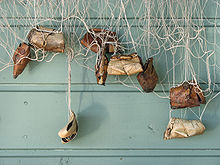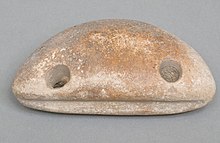Net countersink
Net sinkers are small weights on the lower lines of fishing nets that, in conjunction with net swimmers, hold gillnets vertically in the water (set up). Currently, net countersinks are made of lead, but historically they were made of stone or clay.
history
The earliest evidence of network sinks comes from the Mesolithic . These often consisted of fist-sized stones that are provided with one or more, more or less circumferential notches or with a perforation. On Orkney power lowering agents were ( english fishing sinkers ) of steatite found. In particular, chicken gods were used that have natural holes and do not need to be pierced. Later, net countersinks were also made from clay or lead . A piece of birch bark found at the Federsee , about 30 cm long, rolled several times and filled with clay and pebbles , is also regarded as a net sinker . Net countersinks and fishing hooks made of flint come from the Friesack site in Brandenburg .
literature
- Emil Hoffmann: Lexicon of the Stone Age (= Beck'sche series. Vol. 1325). Beck, Munich 1999, ISBN 3-406-42125-3 .

